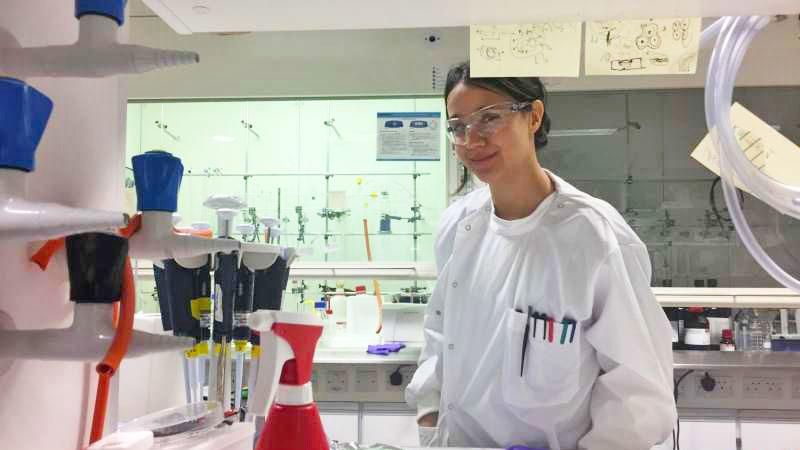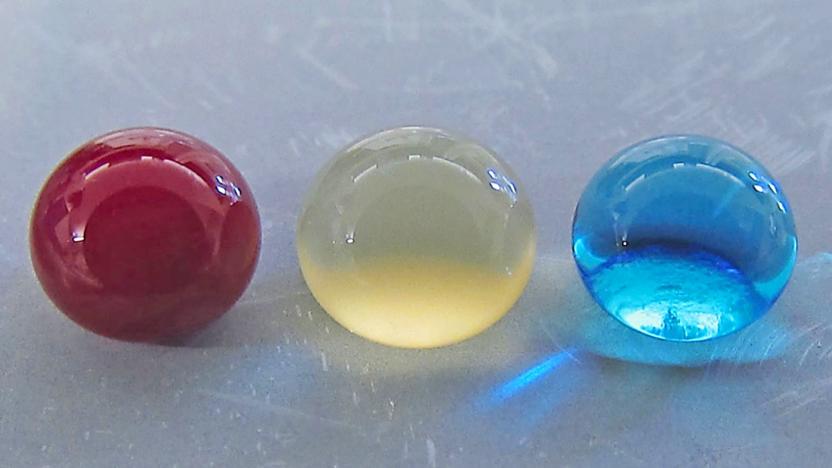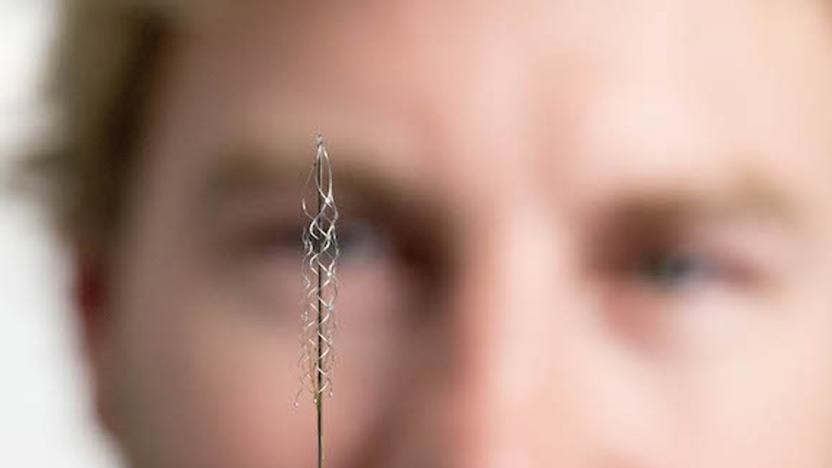implant
Latest

Soft, synthetic retinas may offer a better implant solution
Scientists have been trying to replace retinas in otherwise healthy eyes to help people suffering from diseases like retinitis pigmentosa. Unfortunately, earlier efforts were only able to use rigid, hard materials, which are very different from the natural retina. A researcher at Oxford University, however, has created a synthetic retina made of biological materials to better match natural human tissues. The study, titled "Light-Patterned Current Generation in a Droplet Bilayer Array" was published this April in Scientific Reports.

Retinal implant could add years to your eyesight
Scientists have been struggling to fight retinal degeneration in an elegant way. The most practical solution so far involves external devices that send wires to the back of your eyes. There might be a much more graceful approach before long, however. Researchers have developed an implant whose light-sensitive material could at least partially restore retinas and preserve your eyesight. Their invention combines a biocompatible substance (in this case, silk) with a conductive polymer and an organic semiconductor to send electricity to nerve cells whenever the implant is subjected to typical environmental light. Previous attempts at photovoltaic devices like this have required either exceptionally bright light or unusual light wavelengths to work, so this would be far more practical in the real world.

Blood-repellent metal could lead to safer implants
If you have to get an implant in the future, you may not have to worry quite so much about your body rejecting that life-enhancing technology. Colorado State University scientists have developed a titanium surface that's so blood-repellent that it fools your body into believing that there's no intruder at all. The team grew chemically modified layers that serve as barriers between the metal and organics, blocking any real contact. Fluorinated nanotubes were the most effective method of repelling blood in the experiments.

Bill and Melinda Gates back an implant that could prevent HIV
You don't have to wait until after an infection to fight HIV. A technique known as pre-exposure prophylaxis has you taking preemptive medicine on a regular basis, greatly reducing the chances that HIV will take root in the first place. Needless to say, such a treatment could change the world if done well -- and the Bill & Melinda Gates Foundation wants to make sure that it's as easy as possible. They're investing $140 million in an Intarcia Therapeutics program that will develop an under-the-skin pump implant (you're looking at it above) that will deliver a steady stream of anti-HIV drugs in 6- or 12-month batches. Instead of having to remember to take medicine every day, you'd only have to top up once or twice a year.

A bike accident left him paralyzed; electricity let him ride again
During a prerun of the Baja 1000, one of the world's most treacherous off-road races, Michael McClellan rode his dirt bike out to the front. He traversed the rough terrain of Mexico's northwest peninsula, eventually coming up hard on a washed-up break in the road. In the moment, McClellan decided to take the jump. The front tire made it over the gaping hole, but the back end came up short. The force of the impact crushed his bike and burst the T11 vertebra in his spinal cord, leaving his lower body paralyzed before he even hit the ground.

Titanium-gold alloy could lead to super-strong implants
Many bone implants (such as for hips and teeth) need to be replaced after a decade simply because they're not strong enough to survive for any longer. Rice University might put an end to those regular surgeries, though. Its researchers have crafted a titanium-gold alloy that's the strongest ever to be friendly to organic tissue -- four times stronger than pure titanium, and so strong that the team had trouble grinding it into a powder to check its purity. They created it by preparing titanium-3-gold (that is, three parts titanium for every one part of gold) at a high temperature, forming an extremely sturdy crystal structure.

ICYMI: Squashing brain cancer and autonomous drones arrive
try{document.getElementById("aol-cms-player-1").style.display="none";}catch(e){}Today on In Case You Missed It: The Airobotics drone system can autonomously launch UAVs and perform basic maintenance, like swapping out batteries. Researchers designed a device that agitates bubbles in the blood to get more chemotherapy into the brain by using ultrasonic waves. And Game of Thrones fans might want to see this Night King carved from fruit. As always, please share any interesting tech or science videos you find by using the #ICYMI hashtag on Twitter for @mskerryd.

Brain-machine link helps you steer exoskeletons with your mind
Right now, mind-controlling a machine isn't pretty: you typically wear a silly cap or headset, or else subject yourself to open brain surgery to get a deeper link. Australian scientists might have a better way, though. They've developed a brain-machine interface that taps into your motor cortex through a relatively simple operation -- you won't need to gamble with your health to have a permanent connection to robotics. The device (known as a stentrode) would let you directly steer an exoskeleton or artificial limb through thoughts alone, even if you need the implant for "many months" at a time.

Brain monitoring chips dissolve when you're done with them
By far the biggest danger of brain implants is rejection -- it can be just a matter of time before your immune system freaks out and makes a bad situation that much worse. That's where Washington University might come to the rescue. Its researchers have crafted tiny (smaller than a pencil tip) wireless brain sensors that dissolve. Their mix of silicone and polylactic-co-glycolic acid (PLGA) is sophisticated enough to transmit vital data like cranial pressure and temperature, but melts after a few days of exposure to typical organic matter.

Doctor dubbed 'the father of cyborgs' tested implants in his own brain
How far would you go to create a brain-controlled speech decoder? Doctor Philip Kennedy already helped blaze a trail in brain-computer interfaces back in the 80s. Now, a report in MIT Technology Review explains how the neurosurgeon decided to crank his research up a notch. Well, several notches, really, by having implants put into his own brain to better learn how neurons function with speech. What's more, Kennedy paid $25,000 and underwent highly invasive surgery -- including the removal of the top of his skull -- for the privilege.

Scientists work out how to wire up your brain
Imagine a future where neurological disorders are cured with a single injection into the top of your skull. That's the expectation placed on the shoulders of Charles Lieber, a Harvard chemist who has developed a groundbreaking technology that has the potential to change medicine. The process involves building a tiny fishing net out of conducting threads that can support microscopic sensors across its surface. It's so small that you can use a regular-sized but stronger needle to inject it via a tiny drill hole straight onto the brain. Then, this mesh begins to unfurl and sit on the top of your noggin, shifting around as your grey matter does normally.

Infrared implant brings practical sight to the blind
You can already get a retinal implant to restore some sight when you're blind, but the quality is usually too poor to be useful for more than avoiding collisions. A better solution is close at hand, however: Pixium Vision has successfully tested an implant that should go beyond basic vision. The tiny chip sits just behind the retina and uses infrared light to both stimulate images in your brain and power the whole device. Tests in rats generate vision equivalent to 20/250. That's still far from flawless, but it'd be superior to the 20/500 you can get now -- good enough that you could read the largest letter on an eye doctor's chart. The eventual system for humans, which will use goggles to send images, should manage 20/120 and put wearers above the US' legal standard for blindness. Trial runs start in 2016, so you may not have to wait much longer if you're eager to give the implant a try.

Flexible fiber implants treat your brain without hurting it
Brain implants are limited right now -- they typically measure just one thing at a time, and their stiff wiring can wreck tissue if the device stays in place for long enough. Neither of those problems will matter if MIT's flexible fiber implant becomes a practical reality, though. The school's researchers have developed very thin (almost nanoscale), flexible polymer fibers that have customizable channels for carrying chemicals, electricity and light. These strands could not only treat a patient with drugs and light stimulation, but measure the response with electrodes; you'd know whether or not your medicine is working. The bendy, unintrusive design should also be safe for your body, making it possible to tackle long-term illnesses.

Flexible spinal cord implants will let paralyzed people walk
Doctors dream of helping the paralzyed walk through implants that stimulate their spinal cords, but current technology makes that impossible; these stiff, unnatural gadgets usually end up damaging or inflaming nervous tissue over time. Swiss researchers may have just solved this problem once and for all, though. Their bendy e-Dura implant combines flexible electrodes (made of platinum and silicon microbeads), cracked gold electronic tracks and fluidic microchannels to deliver both electrical impulses and chemicals while mimicking the spine's movements and avoiding friction. Paralyzed rats in lab tests could both walk again after a few weeks and keep wearing their implants after two months.

Nanotech replaces your torn knee ligament without further pain
As Tom Brady and other athletes can attest, you really, really want to avoid tearing your knee's anterior cruciate ligament (ACL). It can't heal up, and the tendon graft used to reconstruct it will likely leave you with permanent pain. Victims may have a much easier time of things if Northwestern University's nanotechnology-infused ligament becomes a practical reality, though. Their remedy combines calcium nanocrystals (like those in your bones), a porous biomaterial and strong polyester fibers to replace your ACL without having to perform grafts and leave you in continued agony. Both the artificial implant and the bone integrate with each other, stabilizing the knee in a way that both lets you move more naturally and spares you from losing some muscle.

PlanetSide 2 implant changes aren't a 'money grab,' Smedley says
Gaming blog In An Age is tracking the recent saga of PlanetSide 2's implant system, noting that the team quietly nerfed the drop rate of free implants and downwardly adjusted the power of tier 1 through 3 implants in order to push sales for the new tier 4 implants. Implants offer temporary buffs or abilities for characters and require an energy cost to activate. SOE President John Smedley defended the move on Twitter: "Sorry, but we are actually trying to make money. I don't consider it a money grab." In a later tweet, he clarified that the team "made the drop rate [for implants] too high a while ago." Commenting on accusations of promoting a pay-to-win environment with these changes, CM Tony Jones responded on Reddit, "Depends on how you define P2W. If implants are P2W, then yes, you may not like everything in the future."

Boy gets the first 3D-printed vertebra implant
3D-printed implants just got one of their biggest real-world tests to date. Peking University Third Hospital has successfully implanted the first 3D-printed vertebra in a 12-year-old boy with cancer in his spinal cord. The bone substitute is made from titanium powder like many orthopedic implants, but promises to be both safer and longer-lasting than conventional replacements. Since it's designed to mimic the shape of the child's original vertebra, it doesn't need cement or screws to stay in place; healing should go faster, too. The construct is full of small holes that let natural bone grow inside, so it should eventually become a permanent, stable part of the spine that won't need adjustments at some point down the road.

Future contraceptives will let women remote-control their fertility
Contraceptive implants are nothing new, but the current generation of progestogen-releasing devices need to be replaced every three years and have to be removed if you want to try for a baby. That may change soon, however, now that the Gates Foundation is backing a Massachusetts biotech company to build the next generation of implantable devices. MicroCHIPS Inc. is building a wirelessly controlled implant that slowly pumps out drugs and could, theoretically, only need replacing once every 16 years.

The US military wants brain implants to treat combat trauma
For soldiers coping with brain injuries and post-traumatic stress, coming home may be tougher than the actual fighting; their conditions can last a lifetime. Long-term relief may be on the horizon for US veterans, though. DARPA is supporting the White House's brain mapping initiative by funding the development of implants (conceptualized below) that alleviate the symptoms of warriors' mental problems, ranging from PTSD to extreme depression. The technology, built by Massachusetts General Hospital, Draper Laboratory and UC San Francisco, will use sensors to watch for unusual neural activity at multiple parts of the brain. If something's wrong, the implants will use deep electrical stimulation to restore healthy activity -- permanently, if possible.

Amped-up ear implant helps to re-grow auditory nerves
Cochlear implants already help those with auditory damage to hear better, but what if they could also grow new nerves while they're there? Scientists at the UNSW have discovered a way to do just that, at least in hamsters. After they introduced a gene therapy solution, a modified cochlear implant used electrical pulses to deliver the treatment directly to auditory nerve cells. That successfully re-generated so-called neurotrophins in the animals, which in turn aided nerve development and significantly improved the implant's effect. Such therapy could one day help the hearing-impaired to pick up sounds better, especially the subtle tones in music. There's a long ways to go prior to human trials, however, since it was only effective in the hamsters for a short time. But it could one day be included as part of cochlear implant therapy and even help other nerve-related conditions, like Parkinson's disease or depression. [Image credit: UNSW Translational Neuroscience Facility]







